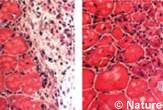Infusion of Young Blood Revives Old Muscles

Old and tired muscles might repair themselves just fine if it weren't for the old blood running through the aging human body, a new study shows.
It's not quite a recipe for the fountain of youth, but the work could lead to methods for healing wounds in the elderly and tackling some diseases.
Stanford neurologist Thomas Rando knew from previous work that aging muscles seemed to have all the ingredients to repair themselves but for some reason did not. In the new work, his team focused on specialized stem cells in muscle tissue.
Stem cells of various kinds are able to make new tissue, so they are key to the body's ability to replenish damaged skin, bone, muscle and more. Satellite muscle stem cells lay dormant when not needed. In young bodies, both of humans and rodents, these cells come alive when muscle is damaged.
In older mice, the study found, satellite stem cells appear normal but don't do their job.
In a test not for the squeamish, Rando and his colleagues fused the blood supplies of younger and older mice. Then they damaged the muscles in the older rodents by zapping spots with dry ice. The muscles healed, thanks to the young blood coursing through their bodies.
In a similar test, the livers of older mice responded better to the infusion of young blood, too. The researchers suspect a similar process might occur with other body cells.
Get the world’s most fascinating discoveries delivered straight to your inbox.
The key to the process appears to involve a protein called delta. When muscles are damaged, satellite muscle cells produce more delta. But in older cells, the delta production doesn't rise. In old mice with young blood, delta again rises in response to injury.
The research demonstrates that "the decline of tissue regenerative potential with age can be reversed through the modulation of systemic factors," the scientists write in the Feb. 17 issue of the journal Nature.
It might seem like the fabled fountain of youth is a sanguine river running through you. But staying forever young is not so simple.
"Basically, the main implications of our findings are not longer life, not a reversal of aging per se, and not really even a delay of the aging process," Rando told LiveScience. "Our findings really speak more the issue of tissue repair, for example in the setting of an acute injury."
Eventually, the research could lead to techniques that would help an older person with a broken bone, a skin wound, or a muscle injury.
"Tissue repair in older people could be enhanced so that it approaches that of younger people," Rando said. The idea is to restore function "not so much to a 'youthful' level but rather back to the point that the person was before the injury."
But there is much work to be done before even that is possible. It's not known what triggers the extra delta production in the muscle. It could be any of the thousands of proteins, lipids, sugars or other molecules in the blood, the researchers caution.
And for now, there's no evidence that the same trigger works for repairing different types of tissues.
"It's as big a fishing expedition as you can possibly imagine," Rando said.
Robert is an independent health and science journalist and writer based in Phoenix, Arizona. He is a former editor-in-chief of Live Science with over 20 years of experience as a reporter and editor. He has worked on websites such as Space.com and Tom's Guide, and is a contributor on Medium, covering how we age and how to optimize the mind and body through time. He has a journalism degree from Humboldt State University in California.



